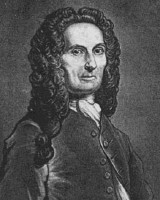

Abraham de Moivre's was raised as a Protestant, but he first attended a tolerant Catholic school. When he was 11, his parents sent him to a Protestant Academy to study Greek, but the Academy was closed for religious reasons, so he studied logic at Saumur until 1684. Although mathematics was not a part of the course that he was studying, de Moivre read mathematics texts in his own time. He continued his studies at the Collège de Harcourt where he took courses in physics and received his first formal mathematics training. Religious persecution of Protestants increased in France, and de Moivre was imprisoned for his religious beliefs. When he was released in 1688, he travelled to England and became a private tutor of mathematics.
By the time he arrived in London, de Moivre was a competent mathematician with a good knowledge of the standard texts. But after discovering Newton's Principia, he realised instantly that this was a work far deeper than those which he had studied. He purchased a copy, and cut up the pages so that he could study them as he travelled from one pupil to the next.
De Moivre met Halley and Newton and became friendly with them. Despite de Moivre's scientific eminence his main income was as a private tutor of mathematics. In 1697, he was elected a fellow of the Royal Society, but he never secured an academic post. In 1710, de Moivre was appointed to the Commission set up by the Royal Society to review the rival claims of Newton and Leibniz to be the discovers of the calculus. His appointment was due to his friendship with Newton, and the Commission ruled in Newton's favor.
De Moivre pioneered the development of analytic geometry and the theory of probability. He published The Doctrine of Chance: A method of calculating the probabilities of events in play in 1711. The definition of statistical independence appears here. The Doctrine of Chance appeared in new expanded editions in 1718, 1738 and 1756, which included the "derangement problem" and the "gamblers ruin" problem for the first time. Laplace and de Moivre are most responsible for the development of probability theory.
The 1756 edition of The Doctrine of Chance contained what is probably de Moivre's most significant contribution to this area, namely the approximation to the binomial distribution by the normal distribution. The work contains the first occurrence of the normal probability integral. He even mentions, although he did not name, the parameter now called the standard deviation.
De Moivre also investigated mortality statistics and the foundation of the theory of annuities. He discovered and published what is now (incorrectly) known as Stirling's formula, n! ∼ √(2πn)(n/e)n. De Moivre is also remembered for what is now called De Moivre's Formula, enix = (cos x + i sin x)n, which took trigonometry into analysis, and was important in the early development of the theory of complex numbers.
He never married, and spent his closing years in peaceful study, until his sight and hearing failed. He was elected a foreign associate of the Paris Academy of Sciences in 1754, but died in poverty.
De Moivre, like Cardan, is famed for predicting the day of his own death. He found that he was sleeping 15 minutes longer each night and summing the arithmetic progression, calculated that he would die on the day that he slept for 24 hours. He was right!